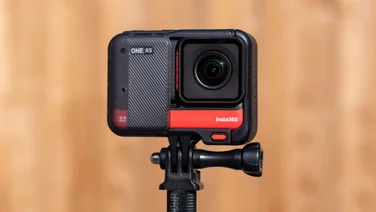To help us provide you with free impartial advice, we may earn a commission if you buy through links on our site. Learn more
























- Great low light image quality
- Motion data logging
- Improved water resistance
- No 5.3K video
- Overheats in some circumstances
- Price hike
Action camera image quality has taken huge steps forwards in recent years but one area they’ve always struggled in is low light quality. The DJI Action 4, however, is different. By increasing the size of the sensor so it’s much larger than the action camera norm, it can record much better quality footage in dimmer conditions.
In fact, while it might not look particularly special – outwardly, it’s almost identical to the Action 3 – DJI’s latest action camera introduces a raft of other new features that make a huge difference to how flexible the camera is to use.
DJI Action 4 review: What do you get for the money?
The Action 4 starts at £379 for the “Standard Combo” package and rises to £469 for the “Adventure Combo”. That’s £70 more expensive than its predecessor was at launch (£309) and pricier than rival cameras from the likes of GoPro and Insta360. Currently, you can pick up a GoPro Hero 11 Black for around £350, while the single lens 4K version of the Insta360 One RS can be had for just £235.

With the Standard Combo package you get the camera itself, a rechargeable battery, a quick release magnetic mount attachment and a protective frame that also lets you mount the camera on its end to shoot vertical video. There’s also a curved adhesive mount included in the box for affixing the Action 4 to a helmet.
If you can afford it, however, the Adventure Combo package is the one to go for. This bundle comes with everything included in the Standard Combo, plus an extra couple of batteries. It also includes a dedicated charging box that allows you to charge all three batteries simultaneously via USB-C and a telescopic selfie stick with GoPro mounting prongs. There are various other packages, too, that focus on specific activities – diving, hiking, cycling etc – and these come with the specific attachments and mounts you need to mount the camera for those activities.

As far as the design of the DJI Action 4 camera itself goes, it’s pretty much the same as its predecessor, the DJI Action 3. Effectively, the design apes that of a GoPro, with the exception of a removable circular protective lens housing rather than the GoPro’s square one. It measures 71 x 44 x 33mm (WDH), weighs 145g and has a pair of colour touchscreens (unlike the GoPro Hero11 Black which only has a touchscreen at the rear). At the front, a 1.4in 320 x 320 resolution display and, at the rear, a 2.25in 360 x 360 resolution one. Both are responsive and give intuitive access to the camera’s various settings.
It uses the same 1,770mAh removable batteries as the Action 3, which is good news if you still have some of those on-hand, and DJI quotes battery life at 160 minutes in 1080p. If you’re shooting in 4K you can expect that to fall dramatically, although I wouldn’t worry too much about this as you’ll probably hit the heat limit long before you exhaust the battery (see below for more details).

The lens, meanwhile, is an f/2.8 unit with a 155-degree field of view. The camera also comes with the same brilliant magnetic mounting system as its predecessor. Unlike the GoPro Hero 11 Black, there are no mounting prongs built into the camera itself; instead, you simply clip a mounting plate magnetically to the base, which is at the same time secured via a couple of clips.
This approach means, if you have a few of these adapter plates, it becomes much easier to move the camera from mount to mount or to remove it to stow it away safely. Simply squeeze the retainer clips at the sides of the adapter plate and pull the camera away from the mount – there’s no fiddly unscrewing required.

As for recording modes, you’re getting most of what a discerning modern action camera enthusiast will be looking for here. Video recording is available at up to 4K at 60fps in 4:3 aspect ratio and up to 120fps in 16:9. There’s a slow motion mode that records at up to 240fps in 1080p resolution and 120fps in 2.7K and 4K modes. And there are dedicated hyperlapse and timelapse modes as well. Stills, meanwhile, are captured at 10MP in both JPEG and RAW formats.
READ NEXT: The best running watches to buy
DJI Action 4 review: What did we like about it?
Hands down the best thing about the DJI Osmo Action 4 is its big 1/1.3in sensor. This is one of the largest action camera sensors we’ve seen yet, surpassing the 1/1.9in sensor in the GoPro Hero 11 Black, the 1/2in sensor in the Insta360 One RS 4K and the 1/1.7in sensor on its predecessor. Insta360 does offer a camera mod for the One RS but that bumps up the cost considerably.
The result is significantly richer, cleaner and more colourful footage in dim conditions. In the comparisons below you can see side-by-side stills grabbed from DJI Osmo Action 5 and the Insta360 One RS with the 4K module attached. There is, simply, no competition between the two. The deep indigo sky is much richer and less noisy on the Action 4’s footage; it’s also worth pointing out how well the camera deals with extremes of shadow and highlights in the same frame. It’s super impressive.Other things I like about the Action 4 include its 4:3 image sensor, which it inherits from its predecessor, and gyroscope, which allows you to record vertical video at full resolution simply by turning the camera on its side. That will be useful for vloggers and the like who record video for platforms such as TikTok, Instagram’s Reels and so on.

The DJI Osmo Action 4’s image quality in low light is exceptional

The same scene captured on the Insta360 One RS looks noisy and drab in comparison
That’s not all though. You can also choose to record motion data from the gyroscope and accelerometers to a separate file and stabilise the video clip in post, rather than in-camera. This has a twofold benefit. On the one hand, it allows you to use a dedicated third party app such as Gyroflow to apply stabilisation, giving you more control over how to balance stabilisation smoothness against the amount of crop. On the other hand, it allows you to record for a little longer before the camera either runs out of battery or overheats.
If you can’t be bothered with the faff, though, DJI’s third generation stabilisation RockSteady 3.0 stabilisation is pretty good. I took it out on a run and compared it side by side with the Insta360 One RS with FlowState stabilisation applied in post, and the Osmo Action 4 won hands down. It can’t quite match the ultra smooth stabilisation offered by the GoPro Hero 11 Black, though.
The camera is also now natively water resistant to 18m. That’s a 2m improvement over the Osmo Action 3 and a whole 8m deeper than you can take the GoPro Hero 11 Black without an additional case.

There’s also a new 10-bit D-Log M colour mode, which replaces the D-Cinelike mode (also 10-bit) on the Action 3. DJI says this adds a little more dynamic range to play with when grading in post. And, lastly, DJI has added GPS to the Osmo Action 4, albeit via the optional remote Bluetooth remote control, which costs £69 extra.
DJI Osmo Action 4 review: What could it do better?
The DJI Osmo Action 4 might beat its rivals for image quality in low light but it can’t match the GoPro Hero11 Black for photo and video resolution. Stills are only 10MP versus the GoPro’s 27MP and its maximum video resolution tops out at 4K where the GoPro can reach heights of 5.3K.
It’s important to note, too, that while vertical video shots can be cropped out of horizontally captured footage with the Osmo Action 4, it’s best to record video with the camera held vertically to maximise image quality. With the GoPro Hero11 Black you don’t have to think about the orientation of the camera much at all, since the original footage is captured at a nearly square 8:7 aspect ratio, allowing you to crop vertical and horizontal clips from the same footage.

Battery life isn’t bad – 160 minutes of 1080p footage from a single charge – although if you jack up the resolution, frame rate and stabilisation to max you can expect that to fall to around an hour.
In testing, at my desk, I managed to extract an hour and six minutes from one charge, although I had to do that in segments because the camera would typically overheat every 20 minutes or so. That may not sound great but it’s similar to what we’ve found with rival action cameras and, once you’re outside with air rushing around the camera casing, you can expect it to last much longer.
READ NEXT: The best GoPro to buy right now
DJI Osmo Action 4 review: Should you buy one?
If DJI had released this camera a year ago at the lower price of £309 I’d have had no hesitation in recommending it as a cheaper alternative to the GoPro Hero11 Black for most people.
As it is, with the price increase to £379, it’s a much more difficult recommendation, especially as it isn’t significantly better than the GoPro Hero11 Black – just a match for it in some respects – and the Hero12 Black is likely to be even better.
With that in mind, I’d recommend waiting for the GoPro Hero12 Black to appear. You shouldn’t have too long to wait and even if the price is higher than the DJI Osmo Action 4 it may well reduce the price of the GoPro Hero11 Black when it does arrive.







